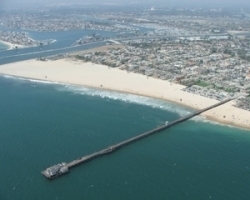A beach without sand is a contradiction in terms.
However, ocean waves erode beaches. So up and down the coast, officials are looking at ways to preserve California’s beach sand.
The public has until Aug. 24 to comment on the Orange County Regional Sediment (sand) Management Program. The final plan is expected to be completed in October. The Orange County plan includes Seal Beach’s east beach.
The beach is one of the main attractions for tourists who visit Seal Beach, which makes the beach important to the local economy. Representatives of the U.S. Army Corps of Engineers and Orange County presented the draft of the plan to Seal Beach residents Tuesday, July 24, in the Seal Beach City Council Chambers.
Sean Crumby, assistant city manager and director of Public Works, estimated that maybe 12 or 15 people attended the meeting.
According to a presentation by Susie Ming, Army Corps of Engineers, the goal of the Sediment Management Plan is to reduce shoreline erosion and restore beaches.
According to a presentation by David Cannon and Seamus Innes of Everest International Consultants, Seal Beach’s east beach is a “high need receiver site.” That means the beach needs to have its sand replaced.
Crumby told the Sun that the beach needs to have its sand replaced every seven to 10 years.
A 1984 study by Moffatt & Nichol Engineers said Seal Beach loses 4,200 to 7,800 cubic yards of sand a year over the Seal Beach Pier Groin and the West Jetty of Anaheim Bay.
Crumby said the responsibility for nourishing Seal Beach’s sand belongs to the city of Seal Beach. A 2009 report said later studies put the loss at 6,000 to 10,000 cubic yards.
That’s not true of all communities. Surfside Colony’s sand, for example, is replenished by the federal government even though Surfside was annexed into the city of Seal Beach a generation ago.
In 1958, Seal Beach suffered massive flooding. In 1959, the federal government installed a sand groin that was expected to end Seal Beach erosion, according to an article in the the Dec. 3, 1959 Orange County edition of the Los Angeles Times.
According to a 2009 report by Tonia McMahon of Moffatt & Nichol Engineers, the city, federal government and California grant monies paid for the 750-foot sand groin. Seal Beach agreed to maintain the groin and the beach.
The groin was damaged in 1983 and rehabilitated in 2006.
In 2009, the Army Corps of Engineers dredged up sand from the bottom of the ocean and placed the sand on the Surfside Colony beach.
At that time, Seal Beach “piggy-backed” on the Army Corps of Engineer project to replenish the east beach sand.
The 2009 McMahon report said the Army Corps of Engineers placed about 2 million cubic yards of material on the Surfside and Sunset Beach beaches to “renourish” beaches affected by the placement of the two Anaheim Bay jetties.
Crumby said the “piggy back” project put 77,000 cubic yards of sand on the beach.
In May 2009, then-City Manager David Carmany reported that the Seal Beach sand project cost the city $1 million.
However, at the Monday, July 23 City Council meeting, District 1 Councilwoman Ellery Deaton estimated that sand replacement usually cost Seal Beach about $2 million. Deaton appeared to be speaking from memory.
Seal Beach has always paid for sand nourishment out of the General Fund, Crumby said. Sand replacement is not in the current city budget.
Crumby said the two jetties were constructed in the 1940s. “We’ve had beach erosion since then,” Crumby said.
He said Seal Beach has been trying to get help with the responsibility of paying for sand replacement for the past 40 to 50 years.
To contact state officials about the draft Orange County Sediment Management Plan, write to David.cannon@everestconsultants.com or write to David Cannon, Everest International Consultants, Inc., at 444 West Ocean Blvd., Suite 1104, Long Beach, CA 90802.
To see the draft report, visit www.dbw.ca.gov/csmw/crsmp_oc.aspx.












